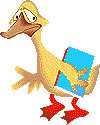| Bird Brains: Sleeping One Half at a Time |
|
How would you like to sleep with one half of your brain asleep and the
other half awake? Dolphins sleep this way. Scientists at
Indiana State University have discovered that ducks sleep this way too.
They have published their findings in the journal Nature, February
4, 1999, volume 397, pages 397-398. These researchers made several observations that suggest that ducks sleep half awake so they can rest and watch for danger at the same time. |
 |
|
|

|
 |
These observations suggest that ducks have developed a way to sleep
and look out for danger at the same time. It is still unknown if the
half-asleep brain can process information. Nevertheless, it is intriguing to think what it would be like to sleep with one brain hemisphere asleep and the other hemisphere awake. Could workers catch a quick nap and still watch for their boss coming around the corner? Could students doze off in class and still pay attention to their teachers? Interesting possibilities! |
References:
More Bird Brains. |
| BACK TO: | Neuroscience In The News | Table of Contents |


![[email]](./gif/menue.gif)



